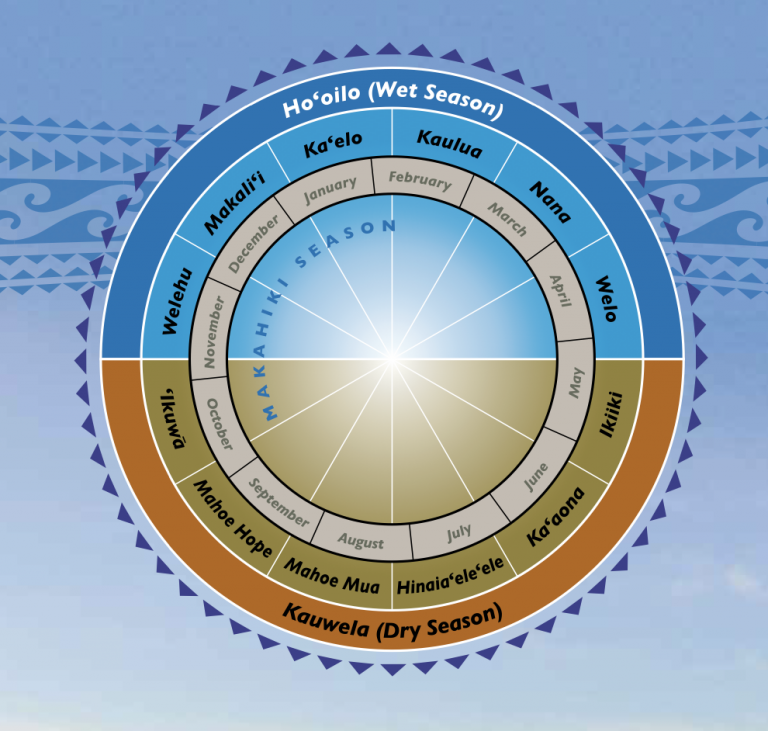The Rhythm of the Moon, The Path of the Canoe: Kaulana Mahina and Outrigger Paddling

For centuries, before the advent of modern navigational tools and weather forecasts, Kanaka Maoli (Native Hawaiians) looked to the heavens and the natural world to guide their way of life. Central to this profound understanding was the Kaulana Mahina, the Hawaiian lunar calendar. This intricate system, far more than just a tracker of days, was a vital guide for fishing, farming, navigation, and resource management. For those who ventured onto the ocean in outrigger canoes – the waʻa – the wisdom of the Kaulana Mahina was, and remains, deeply relevant.
The Hawaiian Lunar Calendar published by the Western Pacific Regional Fishery Management is a beautiful example to reminds us of the deep connections between celestial cycles, environmental conditions, and human activity, particularly those intertwined with the sea.
Navigating by Nature's Clock
The Kaulana Mahina divides the year into months (malama) based on the 29.5-day lunar cycle, further broken into three anahulu, or 10-day periods: hoʻonui (waxing), poepoe (full), and hōʻemi (waning). Each phase and each month was understood to influence the behavior of marine life, the patterns of the tides, and even the weather – all critical factors for outrigger canoeing.
- Understanding the Tides and Currents: The moon's phases directly govern the tides. Paddlers, whether navigating coastal waters or undertaking long voyages, would rely on the Kaulana Mahina to predict tidal patterns. Knowing when currents would be favorable or challenging was essential for safe and efficient travel. The calendar notes how different seasons (Hoʻoilo - wet, and Kauwela - dry) affect when the lowest tides occur, for instance, during Hoʻoilo, the lowest tides during full moon phases (Poepoe) occur at night, while during Kauwela, they occur during daylight hours.
- Following the Fish: For fishing from a waʻa, the lunar calendar was indispensable. It provided insights into when specific fish species would be abundant, when they would be spawning (and thus perhaps under kapu or prohibition), and when they would be most active. For example, the calendar might indicate that during the Welehu moon phase (around November), oʻio spawn nearshore, or that during Kāʻelo (around January), ʻamaʻama run. Lawaiʻa (fishermen) knew that fish tend to be more active and feed aggressively during the new moon, and the days leading up to the full moon were also favorable. This knowledge, guided by the Kaulana Mahina, ensured more successful fishing expeditions from their canoes.
- Weather Wisdom: The calendar describes typical weather patterns associated with different lunar months and seasons. Paddlers would be keenly aware of these traditional forecasts. Knowing that Makaliʻi (around December) could be a wet month with Kona winds, or that ʻIkuwā (around October) could bring rain, thunder, lightning, and high winds, was crucial for planning voyages and ensuring safety at sea.
- Materials for the Waʻa: The health and rhythms of the forests, also observed through the lens of the Kaulana Mahina, provided the materials for the waʻa itself. The calendar highlights plants like hau, whose wood was used for outrigger booms (ʻiako) and floats (ama) and whose flexible branches were braided into rope for canoe lashing. The strong wood of the ʻōhiʻa lehua was also excellent for crafting canoes. Even canoe sails were traditionally made from lau hala (hala leaves), and the knowledge of when to best harvest these materials would have been part of this holistic understanding of the environment. The fibrous husks of the niu (coconut) were also vital for making ʻaha (lashing) for canoes.
A Tradition of Stewardship
Beyond the practical applications, the Kaulana Mahina fostered a deep respect for nature and a commitment to stewardship ('mālama ʻāina'). The kapu system, which included prohibitions on fishing certain species during specific times to protect spawning populations, was guided by this lunar knowledge. Hau branches along the shoreline might even indicate restricted fishing areas. This conservation ethic is vital for the health of the marine environment that sustains the practice of outrigger canoeing.
The calendar itself embodies the Hawaiian concept of "I Ola ʻOe, I Ola Mākou Nei: When You Thrive, We Thrive", emphasizing the interconnectedness of all things. For the outrigger canoe paddler, this means understanding that the health of the ocean, the wisdom of the ancestors encapsulated in the Kaulana Mahina, and the vibrancy of the culture are all interwoven.
In an age of technology, the Hawaiian lunar calendar remains a powerful reminder of the profound ecological wisdom of the kūpuna (ancestors). For those who paddle the waʻa, it offers not just a connection to the past, but a timeless guide to understanding and respecting the rhythms of the ocean world.
